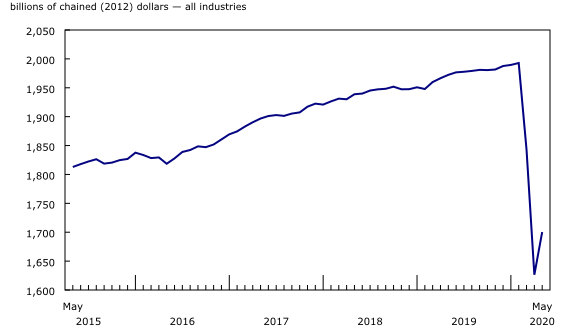Canada’s economy recovering, but still well below pre-pandemic levels
TORONTO, Ont. – Canada’s real GDP rebounded by 4.5% in May, following two months of unprecedented declines, according to the latest data from Statistics Canada released July 31.

However, economic activity remained 15% below February’s pre-pandemic level. For trucking, the important goods producing GDP numbers were up 8%, with 17 of 20 industrial sectors posting increases in May.
The transportation and warehousing sector rose for the first time in five months, led by a 6% increase in truck transportation and 2.3% increase in transportation support activities. StatsCan indicated preliminary data points to about a further 5% increase in real GDP for June, which would indicate a 12% decline in GDP for the second quarter.
U.S. GDP plunges
The situation was far worse in the U.S., which saw its GDP plunge 32.9% in the second quarter, marking its largest ever quarterly drop. That on the heels of a 5% decline in the first quarter.

FTR’s Goods Transport Sector data showed the decline was even worse for trucking, which saw a drop in demand for freight transportation of 40%.
Bob Costello, chief economist of the American Trucking Associations, reacted on Twitter. “Not surprising,” he tweeted. “In fact, a little better than thought – but I’m starting to grow concerned that the economy (is) losing momentum in the third quarter. Freight has been strong in July, but with jobless claims rising, more businesses closing, things could slow down. Something to watch.”
Indeed, U.S. first-time jobless claims rose to 1.434 million for the week ending July 23, the 19th straight week of more than one million initial claims and the second consecutive week of rising claims, according to U.S. Department of Labor data released July 30.
Canada’s small businesses at risk
As the economy recovers from this spring’s economic shutdown months, one in seven small Canadian businesses are at risk of going under, according to a new report from the Canadian Federation of Independent Business (CFIB).
Its mid-range estimate suggests 14%, or 158,000, Canadian small businesses will fail as a result of the Covid-19 pandemic. Depending on how long the economic recovery takes, it could be as low as 5% or as high as 19%. Its mid-range estimate for the transportation, warehousing and utilities segment suggests 15% of small businesses are at risk of failure.
But as reported by Today’s Trucking earlier this week, fewer transportation and warehousing companies are relying on the Canada Emergency Wage Subsidy (CEWS). While 59,280 of the sector’s employees were supported by the program from June 7 to July 4, that’s down dramatically from the 135,470 supported from May 10 to June 6, and 169,860 from April 12 to May 9.
Still, the ability for small businesses to survive will hinge on continued support from government, as well as consumers, the CFIB contends.
“Small businesses are big players in our economy, so minimizing business losses is critical to recovery. Right now, both government support and consumer behavior are critical to transitioning back to conditions that allow businesses to survive and thrive,” said Laura Jones, executive vice-president of CFIB.
The CFIB reports: 62% of small businesses are fully open; 37% are fully staffed; and 26% are making normal sales.
Have your say
This is a moderated forum. Comments will no longer be published unless they are accompanied by a first and last name and a verifiable email address. (Today's Trucking will not publish or share the email address.) Profane language and content deemed to be libelous, racist, or threatening in nature will not be published under any circumstances.